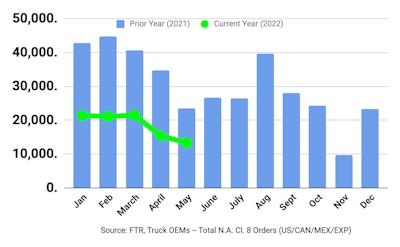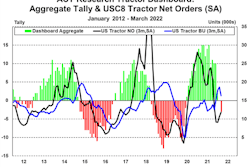
Class 8 truck orders continued their downward trend in May, FTR and ACT Research announced Friday.
FTR reports preliminary North American Class 8 net orders dipped in May to the lowest total since November 2021 at 13,300 units. ACT Research pegged the market at 14,000 preliminary orders, with the Class 5-7 space slightly stronger at 17,000 units. FTR says May was down 13 percent from April and 43 percent year over year. Class 8 orders have totaled 270,000 units over the last 12 months.
Both firms cite never ending supply chain challenges for the continued decline in orders, stating without steady delivery of key components — including semiconductors — OEMs are shrinking their build rates despite high demand. FTR states OEMs are not booking many orders for 2023 because the cost of commodities and other components are inflated and variable, making accurate quoting difficult.
[RELATED: Trailer build slots nearly filled for 2022]
"The supply chain was making slight improvements in the last few months, but some of that progress stalled due to disruptions in China and Russia," says Don Ake, FTR vice president of commercial vehicles. "The OEMs are not confident they can increase production in the second half of the year; therefore, they are not able to take more orders."
"With Class 8 backlogs stretching through 2022 and still no clear visibility on the easing of the all-things shortage, May’s net orders reflect a mild upside surprise, albeit one still in line with the ongoing conservative approach by OEMs looking to limit the risk of overbooking and underbuilding that plagued the industry in 2021," says Eric Crawford, ACT Research vice president and senior analyst.

Crawford also notes that on a seasonally adjusted basis, May's totals are not as bad as they may appear.
"We are coming to that time of year when orders tend to be seasonally weak, as OEMs typically have yet to open their forward-year build schedules, as is currently the case for 2023," he says. "Thus, May’s sequential decline in Class 8 orders from April actually reflects some mild improvement on a seasonally adjusted basis. So despite broader macro uncertainty about Russia/Ukraine, interest rates, and potential recession, the prevailing theme in trucks is largely unchanged: long backlogs and supply-chain constrained production continue to keep new orders trending within a narrow range."
Demand for new trucks generally remains healthy, and Maly says freight is growing and fleets need more trucks to keep up with customer demands and to trade in older vehicles.
"The supply of new trucks has been running way behind demand for over a year now and many fleets need to catch up to their replacement cycles," he says. "This is like ticket sales for a popular concert. At the beginning, sales are high because there are plenty of seats available. But at the end, fewer tickets are sold because there are fewer seats to sell. There just aren’t many build slots still open in 2022. Orders could even slide under 10,000 in the summer months before the cycle begins for next year."
In the Class 5-7 market, Crawford adds, "May’s order moderation for Classes 5-7 follows this segment’s near all-time backlog levels in April."










